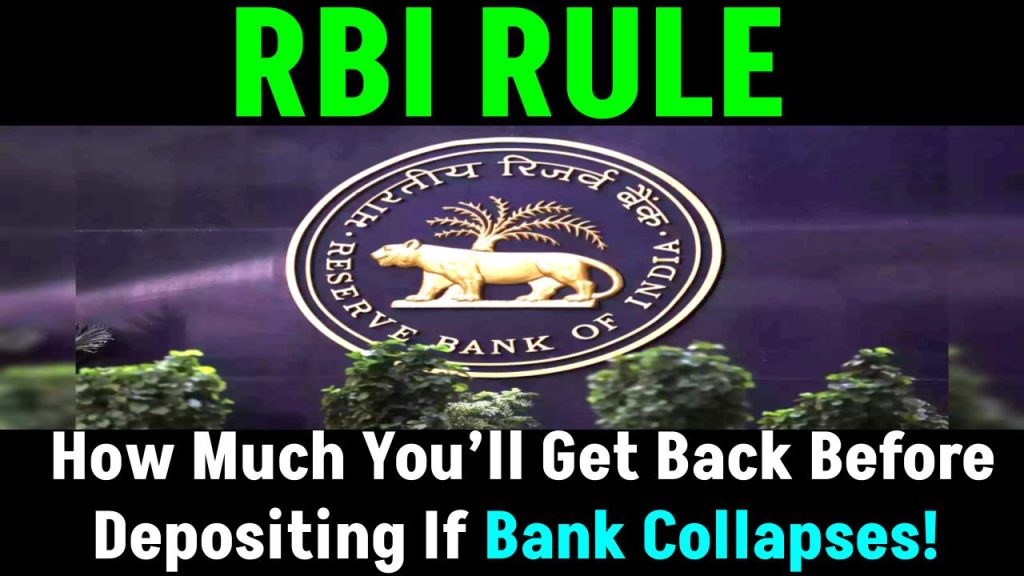
In India, bank deposits are insured up to ₹5 lakh under the Deposit Insurance and Credit Guarantee Corporation (DICGC), a subsidiary of the Reserve Bank of India (RBI). This means that if a bank collapses or goes bankrupt, depositors can only claim up to ₹5 lakh, including both principal and interest. Given the growing concerns around bank stability, it is crucial to understand how deposit insurance works before depositing your money.
If you’ve ever wondered, “What happens to my money if my bank fails?”, this article will break it down for you in a simple, friendly, yet expert-driven manner.
RBI Rule
| Feature | Details |
|---|---|
| Deposit Insurance Limit | ₹5 lakh per depositor, per bank (including principal and interest) |
| Covered Accounts | Savings, current, fixed deposits (FDs), recurring deposits (RDs) |
| Who Provides Insurance? | DICGC (subsidiary of RBI) |
| What If I Have Multiple Accounts? | All deposits within the same bank are combined under the ₹5 lakh limit |
| Joint Accounts? | Joint account deposits are separately insured if the ownership is different |
| Multiple Banks? | The ₹5 lakh limit applies separately to each bank |
| When is the Money Paid? | Within two months of claim processing (but may take longer in some cases) |
| Where to Check If a Bank Is Covered? | Official DICGC Website |
While banks rarely collapse, it’s always wise to plan for worst-case scenarios. The ₹5 lakh deposit insurance rule ensures basic protection, but higher amounts are at risk. To safeguard your hard-earned money:
- Spread deposits across banks
- Use different account ownerships
- Monitor bank stability regularly
For the latest updates, visit the DICGC official website.
Also Check: The government is giving so many thousand rupees for marriage in UP, only these people can apply
RBI Rule: What Is Deposit Insurance and Why Does It Matter?
Imagine this scenario: Your bank suddenly shuts down due to financial trouble. What happens to your hard-earned savings? This is where deposit insurance comes in.
- Deposit insurance protects your money in case of a bank failure.
- The RBI, through DICGC, ensures that depositors receive up to ₹5 lakh per bank.
- Without this protection, you could lose all your money in case of a bank collapse.
How Does Deposit Insurance Work?
- You deposit money in a bank.
- The bank pays a premium to DICGC to insure your deposits.
- If the bank collapses or goes bankrupt, DICGC reimburses you up to ₹5 lakh.
- The remaining amount (if your deposits exceed ₹5 lakh) is not guaranteed.
Example:
If you have ₹3 lakh in a fixed deposit and ₹2 lakh in a savings account with the same bank, you are fully covered.
However, if you have ₹8 lakh in total, only ₹5 lakh is protected, and the rest depends on the bank’s liquidation process.
RBI Rule: Understanding the ₹5 Lakh Coverage Limit
Many depositors misunderstand how the ₹5 lakh limit applies. Let’s break it down:
Coverage Is Per Depositor, Per Bank
- If you have multiple accounts (savings, current, FDs, RDs) in the same bank, the insurance applies to the total amount.
- Example: ₹2 lakh in savings + ₹3 lakh in FD = Fully covered (₹5 lakh limit reached).
Joint Accounts Get Separate Coverage
- If an account is jointly held, it is separately insured provided the ownership combination is different.
- Example:
- Account A: Rahul & Priya (₹5 lakh insured separately)
- Account B: Rahul & Aakash (₹5 lakh insured separately)
Multiple Banks = More Coverage
- If you have deposits across different banks, each bank’s deposits are insured separately.
- Example:
- ₹5 lakh in SBI → Fully insured
- ₹5 lakh in HDFC Bank → Fully insured
- ₹5 lakh in ICICI Bank → Fully insured
- Total insurance coverage = ₹15 lakh (₹5 lakh per bank)
Tip: Spreading your money across different banks can increase your overall insurance coverage!
Also Check: Property News: Big decision of the court, daughter will not get any rights in father’s property!
RBI Rule: Which Banks Are Covered Under DICGC?
The good news is that most banks in India are covered under DICGC. This includes:
- Public Sector Banks (e.g., SBI, Bank of Baroda, PNB)
- Private Banks (e.g., HDFC Bank, ICICI Bank, Axis Bank)
- Cooperative Banks (e.g., Saraswat Bank, Shamrao Vithal Bank)
- Foreign Banks with Indian Operations (e.g., Citibank, HSBC)
- Regional Rural Banks (RRBs)
Not Covered:
- Deposits in NBFCs (like Bajaj Finance)
- Deposits in Cooperative Societies
- Mutual Funds, Stocks, Bonds
RBI Rule: What Happens If a Bank Fails?
If a bank collapses, here’s how the claim process works:
Bank Fails
- The RBI suspends operations of the troubled bank.
- The bank stops allowing withdrawals from customers.
Liquidation & Claim Processing
- The bank’s liquidator submits depositor claims to DICGC.
- DICGC verifies claims and processes payments.
Payout Within Two Months
- DICGC aims to pay insured deposits within 2 months of receiving the claim list.
- If deposits exceed ₹5 lakh, depositors must wait for liquidation proceedings, which can take years.
Recent Example: In 2021, Punjab & Maharashtra Co-operative (PMC) Bank collapsed. Thousands of depositors had over ₹5 lakh in deposits and are still waiting for their money.
Also Check: RBI’s New Rules Make Personal Loans HARDER to Get! Check What’s Changed!
RBI Rule: How to Protect Your Money Beyond ₹5 Lakh?
Since the ₹5 lakh limit is fixed, here are some smart strategies to safeguard your savings:
- Distribute Deposits Across Multiple Banks
- Use Different Ownership Combinations for Joint Accounts
- Diversify Into Other Assets (e.g., Mutual Funds, Gold, Government Bonds)
- Regularly Check RBI’s List of Weak Banks to avoid risky institutions
RBI Rule (FAQs)
What types of deposits are insured under DICGC?
Savings accounts, fixed deposits (FDs), current accounts, and recurring deposits (RDs) in covered banks.
Can I claim more than ₹5 lakh if my bank fails?
No. The maximum you can claim is ₹5 lakh per bank. Anything beyond that depends on liquidation.
How long does it take to receive insured money?
DICGC aims to pay within 2 months after receiving claims, but delays may occur.
What happens to deposits in NBFCs like Bajaj Finance?
NBFC deposits are NOT covered under DICGC insurance.
Is money in a foreign bank branch in India covered?
Yes, if the bank operates under RBI regulation.









